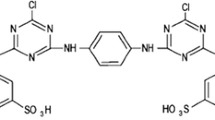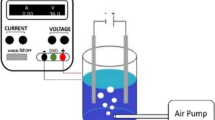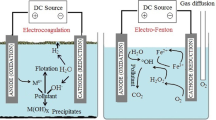Abstract
This study is carried out to investigate the effect of the cathodic contribution in the performance of electro-oxidation process for decolorization of the textile wastewater effluent pre-treated with a lab-scale moving bed-membrane bioreactor. For this purpose, titanium dioxide (TiO2) was used as anode electrode and four different cathodic electrode materials: Graphite, TiO2, TiO2-coated Platine, and TiO2-coated ruthenium dioxide (RuO2) (namely RuO2) were tested and compared for their color removal efficiencies. Besides, the optimization parameters that affect color removal in correspondence to the electrode materials, such as applied current, electrolysis time, and pH were studied. In this context, the optimum parameters for each electrode material were selected, and the color removal percentages were found as 92.95%, 91.58%, 91.40%, and 89.17% for TiO2/Graphite, TiO2/Platine, TiO2/TiO2, and TiO2/RuO2, respectively. Finally, the operational cost for each of the tested cathodic electrode materials was calculated in each of the studied optimization parameters making it easier and practical for the selection and evaluation of the electrode materials by the readers. The correlation coefficients (R2) were 81.2%, 87.1%, 86.7%, and 88.6% respectively as a result of the optimization study using the nonlinear regression modeling.










Similar content being viewed by others
References
Abu Ghalwa NM, Zaggout FR (2006) Electrodegradation of methylene blue dye in water and wastewater using lead oxide/titanium modified electrode J Environ Sci Health A 41:2271-2282
Allen SJ, Khader KY, Bino M (1995) Electrooxidation of dyestuffs in waste waters Journal of Chemical Technology & Biotechnology: International Research in Process, Environ and Clean Technol 62:111-117
Anglada A, Urtiaga A, Ortiz I (2009) Contributions of electrochemical oxidation to waste-water treatment: fundamentals and review of applications. J Chem Technol Biotechnol 84:1747–1755
Anouzla A, Abrouki Y, Souabi S, Safi M, Rhbal H (2009) Colour and COD removal of disperse dye solution by a novel coagulant: application of statistical design for the optimization and regression analysis. J Hazard Mater 166:1302–1306
Azzam M, Tahboub Y, Al-Tarazi M (1999) Effect of counter electrode material on the anodic destruction of 4-Cl phenol solution. Process Saf Environ Prot 77:219–226
Baddouh A, El Ibrahimi B, Rguitti MM, Mohamed E, Hussain S, Bazzi L (2020) Electrochemical removal of methylene bleu dye in aqueous solution using Ti/RuO2–IrO2 and SnO2 electrodes. Sep Sci Technol 55:1852–1861
Baliarsingh S, Panda AK, Jena J, Das T, Das NB (2012) Exploring sustainable technique on natural dye extraction from native plants for textile: identification of colourants, colourimetric analysis of dyed yarns and their antimicrobial evaluation. J Clean Prod 37:257–264
Carneiro PA, Osugi ME, Fugivara CS, Boralle N, Furlan M, Zanoni MVB (2005) Evaluation of different electrochemical methods on the oxidation and degradation of reactive blue 4 in aqueous solution. Chemosphere 59:431–439
Chianeh FN, Avestan MS (2020) Application of central composite design for electrochemical oxidation of reactive dye on Ti/MWCNT electrode. J Iran Chem Soc 17:1073–1085
Chou W-L, Wang C-T, Chang C-P (2011) Comparison of removal of Acid Orange 7 by electrooxidation using various anode materials. Desalination 266:201–207
Deborde M, Von Gunten U (2008) Reactions of chlorine with inorganic and organic compounds during water treatment—kinetics and mechanisms: a critical review. Water Res 42:13–51
Dos Santos AB, Cervantes FJ, van Lier JB (2007) Review paper on current technologies for decolourisation of textile wastewaters: perspectives for anaerobic biotechnology. Bioresour Technol 98:2369–2385
El-Zawahry MM, Abdelghaffar F, Abdelghaffar RA, Hassabo AG (2016) Equilibrium and kinetic models on the adsorption of Reactive Black 5 from aqueous solution using Eichhornia crassipes/chitosan composite. Carbohydr Polym 136:507–515
Erkan HS, Çağlak A, Soysaloglu A, Takatas B, Engin GO (2020) Performance evaluation of conventional membrane bioreactor and moving bed membrane bioreactor for synthetic textile wastewater treatment. J Water Process Eng 38:101631
Fan L, Zhou Y, Yang W, Chen G, Yang F (2008) Electrochemical degradation of aqueous solution of Amaranth azo dye on ACF under potentiostatic model. Dyes Pigments 76:440–446
Farizoğlu B, Fil BA, Uzuner S, Bıçakcı S, Er E, Kara EN (2018) Reactive black 5 removal with electro-oxidation method using ti/ıro2/ruo2 anode and stainless steel cathode
Forgacs E, Cserhati T, Oros G (2004) Removal of synthetic dyes from wastewaters: a review. Environ Int 30:953–971
Ganzenko O, Huguenot D, Van Hullebusch ED, Esposito G, Oturan MA (2014) Electrochemical advanced oxidation and biological processes for wastewater treatment: a review of the combined approaches. Environ Sci Pollut Res 21:8493–8524
Ghalwa NA, Abdel-Latif MS (2005) Electrochemical degradation of acid green dye in aqueous wastewater dyestuff solutions using a lead oxide coated titanium electrode. J Iran Chem Soc 2:238–243
Gharibian S, Hazrati H, Rostamizadeh M (2020) Continuous electrooxidation of Methylene Blue in filter press electrochemical flowcell: CFD simulation and RTD validation. Chem Eng ProcessProcess Intensification 150:107880
Gutierrez M, Crespi M (1999) A review of electrochemical treatments for colour elimination. Color Technol 115:342–345
Hassan MM, Carr CM (2018) A critical review on recent advancements of the removal of reactive dyes from dyehouse effluent by ion-exchange adsorbents. Chemosphere 209:201–219
Hessel C, Allegre C, Maisseu M, Charbit F, Moulin P (2007) Guidelines and legislation for dye house effluents. J Environ Manag 83:171–180
C-c J, J-f Z (2007) Progress and prospect in electro-Fenton process for wastewater treatment. J Zhejiang University-SCIENCE A 8:1118–1125
Ju P, Fan H, Guo D, Meng X, Xu M, Ai S (2012) Electrocatalytic degradation of bisphenol A in water on a Ti-based PbO2–ionic liquids (ILs) electrode. Chem Eng J 179:99–106
Kahraman Ö, Şimşek İ (2020) Color removal from denim production facility wastewater by electrochemical treatment process and optimization with regression method. J Clean Prod 267:122168
Kaur P, Kushwaha JP, Sangal VK (2017) Evaluation and disposability study of actual textile wastewater treatment by electro-oxidation method using Ti/RuO2 anode. Process Saf Environ Prot 111:13–22
Kobya M, Ozyonar F, Demirbas E, Sik E, Oncel M (2015) Arsenic removal from groundwater of Sivas-Şarkişla Plain, Turkey by electrocoagulation process: comparing with iron plate and ball electrodes. J Environ Chem Eng 3:1096–1106
Lee YH, Pavlostathis SG (2004) Decolorization and toxicity of reactive anthraquinone textile dyes under methanogenic conditions. Water Res 38:1838–1852
Li W, Liu G, Miao D, Li Z, Chen Y, Gao X, Liu T, Wei Q, Ma L, Zhou K, Yu Z (2020) Electrochemical oxidation of Reactive Blue 19 on boron-doped diamond anode with different supporting electrolyte. J Environ Chem Eng 8:103997
Ling Y, Hu J, Qian Z, Zhu L, Chen X (2016) Continuous treatment of biologically treated textile effluent using a multi-cell electrochemical reactor. Chem Eng J 286:571–577
Martínez-Huitle CA, Brillas E (2009) Decontamination of wastewaters containing synthetic organic dyes by electrochemical methods: a general review. Appl Catal B Environ 87:105–145
Medel A, Treviño-Reséndez J, Brillas E, Meas Y, Sirés I (2020) Contribution of cathodic hydroxyl radical generation to the enhancement of electro-oxidation process for water decontamination. Electrochim Acta 331:135382
Naim MM, El Abd YM (2002) Removal and recovery of dyestuffs from dyeing wastewaters. Separation and Purification Methods 31:171–228
Oelkers EH, Hering JG, Zhu C (2011) Water: is there a global crisis. Elements 7:157–162
Panizza M, Cerisola G (2008) Electrochemical degradation of methyl red using BDD and PbO2 anodes. Ind Eng Chem Res 47:6816–6820
Panizza M, Cerisola G (2009) Direct and mediated anodic oxidation of organic pollutants. Chem Rev 109:6541–6569
Pletcher D, Walsh FC (2012) Industrial electrochemistry. Springer Science & Business Media,
Rangel M, Nava JL, Peralta-Hernández JM, Carreño G, Guerra-Sánchez RJ (2013) Electrochemical oxidation of Reactive Blue 222 on boron-doped diamond electrodes Int J Electrochem Sci 8:3310
Robinson T, McMullan G, Marchant R, Nigam P (2001) Remediation of dyes in textile effluent: a critical review on current treatment technologies with a proposed alternative. Bioresour Technol 77:247–255
Sahinkaya E, Uzal N, Yetis U, Dilek FB (2008) Biological treatment and nanofiltration of denim textile wastewater for reuse Journal of hazardous materials 153:1142-1148
Sala M, Gutiérrez-Bouzán MC (2014) Electrochemical treatment of industrial wastewater and effluent reuse at laboratory and semi-industrial scale Journal of cleaner production 65:458-464
Sarayu K, Sandhya S (2012) Current technologies for biological treatment of textile wastewater–a review. Appl Biochem Biotechnol 167:645–661
Singh S, Lo SL, Srivastava VC, Hiwarkar AD (2016) Comparative study of electrochemical oxidation for dye degradation: parametric optimization and mechanism identification. J Environ Chem Eng 4:2911–2921
Suseno, Sajidan, Masykuri M, Setyono P The effect of NaCl concentration and process time in continuous electrooxidation technique for degradation of textile dyestuffs. In: AIP Conference Proceedings, 2019. vol 1. AIP Publishing LLC, p 030025
Tavares MG, da Silva LV, Solano AMS, Tonholo J, Martínez-Huitle CA, Zanta CL (2012) Electrochemical oxidation of methyl red using Ti/Ru0. 3Ti0. 7O2 and Ti/Pt anodes. Chem Eng J 204:141–150
Trabelsi SK, Tahar NB, Trabelsi B, Abdelhedi R (2005) Electrochemical oxidation of ferulic acid in aqueous solutions at gold oxide and lead dioxide electrodes. J Appl Electrochem 35:967–973
Tsantaki E, Velegraki T, Katsaounis A, Mantzavinos D (2012) Anodic oxidation of textile dyehouse effluents on boron-doped diamond electrode. J Hazard Mater 207:91–96
Turan NB (2020) The application of hybrid electrocoagulation–electrooxidation system for the treatment of dairy wastewater using different electrode connections. Sep Sci Technol:1–14
Verma AK, Dash RR, Bhunia P (2012) A review on chemical coagulation/flocculation technologies for removal of colour from textile wastewaters. J Environ Manag 93:154–168
Yazici B, Tatli G, Galip H, Erbil M (1995) Investigation of suitable cathodes for the production of hydrogen gas by electrolysis. Int J Hydrog Energy 20:957–965
Zhan X, Wang J, Wen X, Qian Y (2001) Indirect electrochemical treatment of saline dyestuff wastewater. Environ Technol 22:1105–1111
ZHANG Q, Bo K, Hong X, H-b LIN (2006) Indirect electrochemical oxidation of 4-amino-dimethyl-aniline hydrochloride. Chem Res Chin Univ 22:360–363
Availability of data and materials
The datasets used and/or analyzed during the current study are available from the corresponding author on reasonable request.
Author information
Authors and Affiliations
Contributions
All authors contributed to the study conception and design. Material preparation, data collection, and analysis were performed by [NBT] and [HSE]. The first draft of the manuscript was written by [NBT]. Manuscript revision and editing were performed by [HSE], [FI], and [GOE]. All authors commented on previous versions of the manuscript. All authors read and approved the final manuscript.
Corresponding author
Ethics declarations
Ethics approval and consent to participate
Not applicable
Consent for publication
Not applicable
Additional information
Responsible editor: Weiming Zhang
Publisher’s note
Springer Nature remains neutral with regard to jurisdictional claims in published maps and institutional affiliations.
Rights and permissions
About this article
Cite this article
Bakaraki Turan, N., Sari Erkan, H., İlhan, F. et al. Highlighting the cathodic contribution of an electrooxidation post-treatment study on decolorization of textile wastewater effluent pre-treated with a lab-scale moving bed-membrane bioreactor. Environ Sci Pollut Res 28, 25972–25983 (2021). https://doi.org/10.1007/s11356-021-12409-8
Received:
Accepted:
Published:
Issue Date:
DOI: https://doi.org/10.1007/s11356-021-12409-8




